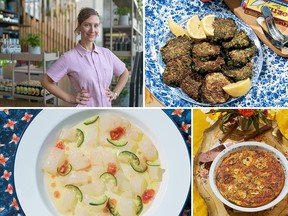‘Take a picnic blanket to a community garden, have a challah and a few salads and something very quick to make, and enjoy it’

Article content
Reviews and recommendations are unbiased and products are independently selected. Postmedia may earn an affiliate commission from purchases made through links on this page.
Our cookbook of the week is The Jewish Holiday Table by Naama Shefi and the Jewish Food Society with Devra Ferst.
Jump to the recipes: spinach rissoles (fritters), preserved fish and zucchini pashtida (casserole).
Advertisement 2
Article content
A single meal spurred Naama Shefi to start the Jewish Food Society. At the first Shabbat dinner she shared with her now-husband Ilan’s family in 2006, the hospitality of his grandmother, Ketty, and the legacy of the dishes on the table left an indelible mark. The menu reflected Ketty’s journey from Turkey, Greece and Zimbabwe to Israel, and Shefi knew then that she wanted to help safeguard her culinary heritage.
Since Shefi founded the Jewish Food Society in New York City in 2017, it has amassed more than 1,000 recipes in its digital archive — each tested, photographed and accompanied by an essay based on oral history. In the nonprofit’s first cookbook, The Jewish Holiday Table (Artisan, 2024), Shefi and co-author Devra Ferst chose 135 recipes to feature unfolding with the seasons.
“It’s definitely a gift,” Shefi says of the archive. “The work was really a work of curation and how to tell this wider story. In many ways, I think of the book as a love letter to our diverse heritage and community. And I think that, especially at this moment in time, it’s important to showcase this diversity.”
Advertisement 3
Article content
Following the Jewish agricultural calendar — Rosh Hashanah, Yom Kippur and Sukkot in fall, Hanukkah and Purim in winter, Passover and Shavuot in spring and, “a holiday for every season,” Shabbat (the Jewish day of rest that begins on Fridays before sunset) — Shefi and Ferst featured the menus and stories of 30 families. They set out to shine a light on the seasonality of Jewish cuisine and the lesser-known traditions of communities that are not often celebrated.
The strength of the storytelling was as vital as the deliciousness of the recipes. One featured family emigrated from Baghdad to Kolkata, India, in 1877. Another left Spain for Morocco before immigrating to Belem, Brazil, in the late 1890s, and yet another travelled from Ethiopia to Sudan on foot before settling in Harlem, New York.
“It’s so incredible and interesting to know about them and celebrate their stories and their unique adaptation to the recipes and the traditions they kept. In many ways, sure, it’s a cookbook, but to me, it’s a history book, and it brings Jewish stories from the diaspora and puts it together to celebrate our heritage.”
Article content
Advertisement 4
Article content
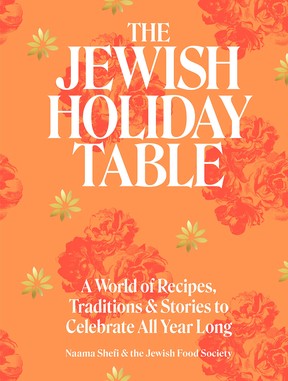
Dishes may be expressed differently across the diaspora, but there are commonalities, says Shefi — especially in how they were designed to keep Shabbat and follow dietary laws. On book tour, several audience members asked Shefi what she considers the most Jewish ingredient. At first, she said onions. “Chicken casserole, chopped liver, pashtida, whatever, whatever, there will be onions.” But after some reflection, she arrived at a different answer: time.
As the authors highlight in The Jewish Holiday Cookbook, many dishes use time as the primary ingredient because of Shabbat restrictions on 39 categories of labour in religious homes. Even though Shefi isn’t religious, she cooks many Shabbat dishes overnight, such as cholent, t’bit and adafina (a.k.a. dafina). “It’s like magic. You cook while you sleep, and it feels special — the deep colour.”
Shefi grew up on Kibbutz Givat HaShlosha in central Israel and left in 2005 to do a master’s degree in film in New York City, where she still lives. Initially, her goal was to document Jewish recipes and stories on video, but after experimenting with different formats, she landed on an archive that combined essays, photography, and recipes. At the Jewish Food Society, they spend time with people in their kitchens to capture their dishes and stories. They then develop the recipes in their test kitchen and style and photograph them in-house.
Advertisement 5
Article content
When Shefi founded the nonprofit, they had a “mega-list” of Jewish food icons and uniquely Jewish dishes from across the diaspora they wanted to preserve. After about a year, people started submitting recipes from around the world. Today, they’re still searching for unique dishes and traditions, and their scope has widened, including people who have converted to Judaism and celebrate with dishes from their own cultures.
Featuring three to five families’ menus and stories for each holiday allowed them to show the spectrum of the Jewish experience. “You can really see the hospitality.” Startup founder and home cook Idan Cohen, for example, shared his family’s cake recipes for a pre-Shabbat, post-schlafstunde (afternoon rest) ritual: poppy seed babka, “stadium cake” (Paris-Brest-style pastry) and strawberries-and-cream roulade. Including just one of the three recipes would have only told part of the story of this unique tradition, says Shefi.
“That’s their Shabbat, and I love how he described that his religion is a German custom of having cakes after schlafstunde on Friday. First of all, we all need to bring back this tradition of just taking a nap in the middle of the day,” says Shefi, laughing. “Wouldn’t it be nice? But I think we would have lost a lot of information and character if we had followed the regular structure of cookbooks.”
Advertisement 6
Article content
Despite having grown up “in the most secular place of all,” a kibbutz, Shefi always felt connected to her Jewish identity. When she moved to New York as a young adult, she found food as “a more modern, cultural” way to deepen that connection. Today, Shefi feels an even greater urgency to preserve and celebrate Jewish cuisine. She mentions one of the families they featured in the Passover chapter, the Stulmans, who share Mimouna (a celebration dinner held the day after Passover) with their neighbours in Virginia, as they once did in Rabat, Morocco.
When the Stulmans immigrated to the U.S. in the early 1970s, they were the only Moroccan Jewish family in their community. Ruth Stulman shared how her mother, Perla, kept their traditions alive. “(Ruth) said that they could have easily just blended in — be quiet, be Americans and blend in, basically — but her mom chose to host Mimouna every year. To put on the djellabas and the traditional clothing, the music, and all these amazing spreads for Mimouna and to stick with their tradition. This is just a simple story, but today, I go back to this story and take a lot of inspiration from this choice. And there are so many other stories — this is just one small example. The book is filled with stories about resilience and pride. That’s what I feel is my calling, to share these stories.”
Advertisement 7
Article content
Recommended from Editorial
-

Cook This: 3 recipes from Plant Magic, including herby potato salad
-

Cook This: 3 Turkish recipes from Sebze, including a summery meze
SPINACH RISSOLES
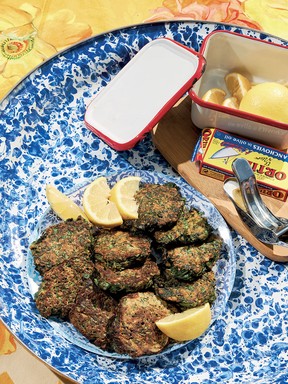
Spinach Fritters
Makes: 6 to 8 servings; about 24 fritters
1 large bunch spinach (about 1 lb/450 g), stems trimmed off, leaves rinsed and dried
4 large eggs, lightly beaten
2/3 cup (85 g) all-purpose flour
2/3 cup (35 g) panko-style breadcrumbs
1 tsp kosher salt
1/4 tsp freshly ground black pepper
Vegetable oil for shallow-frying
Lemon wedges for serving
Step 1
Finely chop the spinach leaves; you should have about 7 lightly packed cups (340 g).
Step 2
Put the spinach in a large bowl and add the eggs, flour, breadcrumbs, salt and pepper. Stir vigorously to mix well, then let the mixture sit for about 5 minutes so the flour and crumbs can absorb the moisture.
Step 3
Line a large platter with paper towels. Pour about 1/4 inch (6 mm) of oil into a large skillet and heat over medium-high heat until hot. Using a large soup spoon, scoop up some of the spinach mixture and add it to the pan, patting it down with the spoon to make a small patty about 2 inches (5 cm) in diameter. Add a few more scoops, but don’t crowd the pan. (If the first patty doesn’t hold together in the pan, stir a few more breadcrumbs and another sprinkling of flour in the spinach mixture and try again.)
Advertisement 8
Article content
Step 4
Fry the spinach fritters until lightly browned on the first side and starting to firm up a bit, 3 to 4 minutes. Carefully flip the fritters (they’ll still be slightly fragile) and cook until the other side is browned in spots and the fritter feels cooked. The fritters won’t become entirely browned; you’ll see a few browned spots but you’ll mostly see dark green spinach.
Step 5
Transfer the fritters to the paper towel-lined platter and continue with the rest of the spinach mixture, scooping out any little bits that may burn from the pan and adding more oil as needed; let the new oil heat up before adding more of the fritter mixture.
Step 6
Serve the fritters hot or at room temperature, with lemon wedges.
PRESERVED FISH
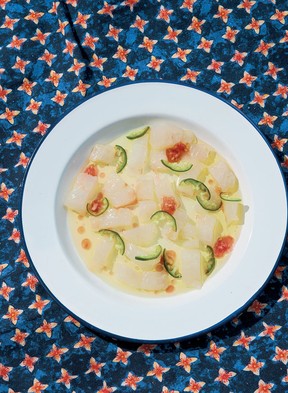
Makes: 6 to 8 servings
1/2 cup (70 g) kosher salt
1 lb (450 g) skinless red snapper fillets
Extra-virgin olive oil
For serving:
1 small serrano chili, cored, seeded and thinly sliced
1 ripe tomato, halved
Fresh lemon juice (optional)
Flaky salt
Bread
Step 1
Cover a plate generously with kosher salt. Lay the fish fillets on the salt and spread more salt over the top of the fish. Cover the plate and refrigerate for 25 minutes.
Advertisement 9
Article content
Step 2
Fill a large bowl with ice water. Rinse the salted fish in the ice water and pat completely dry with paper towels.
Step 3
Cut the fish into rectangular strips about 1/2 inch (1.25 cm) wide and 1 1/2 to 2 inches (4 to 5 cm) long; your pieces will depend on the shape of your fish fillets.
Step 4
Place the fish in a sterilized 1-pint (500 mL) mason jar or other glass container. Pour in enough olive oil to cover the fish.
Step 5
To serve immediately, gently lift the fish pieces from the jar, letting the excess oil drain off, and arrange in one layer on a serving plate. Drizzle with olive oil, sprinkle with about 5 slices of serrano, and squeeze the juices and seeds of the tomato over the fish. Squeeze on a few drops of lemon juice, if using, sprinkle with flaky salt, and serve with bread.
Step 6
To prepare in advance, seal the jar or container, place in the refrigerator, and let cure for up to 4 days. Let come to room temperature, then serve as above.
ZUCCHINI PASHTIDA
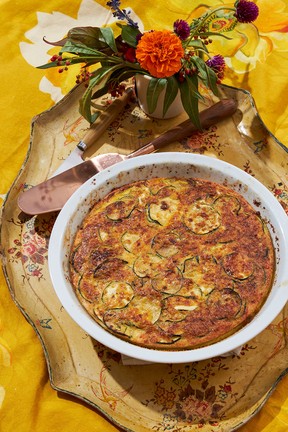
Zucchini Casserole
Makes: 6 to 8 servings
Extra-virgin olive oil
2 tbsp panko-style or regular dry breadcrumbs, plus more for the pan
1 large onion (about 10 oz/280 g), finely chopped
1 to 1 1/4 lb (450 to 560 g) zucchini (2 to 3 medium), sliced into thin rounds
Kosher salt
3 large eggs
3/4 cup (190 g) plain whole-milk Greek yogurt
1/2 cup (50 g) plus 2 tbsp finely grated hard cheese, such as Parmesan, kasseri or kashkaval
1/4 cup (60 ml) whole milk
1/4 cup (30 g) all-purpose flour
Freshly ground black pepper
2 to 3 tbsp chopped fresh dill or flat-leaf parsley, or a mix
Advertisement 10
Article content
Step 1
Place a rack in the upper third of the oven and preheat the oven to 350F (175C). Grease a 9-inch (22.5 cm) pie pan with olive oil. Dust the pan with breadcrumbs and tap out any excess crumbs.
Step 2
In a large skillet, heat 3 tablespoons olive oil over medium heat. Add the onion and cook, stirring occasionally, until very soft and fragrant, 8 to 10 minutes. Transfer the onion to a large plate or tray and set aside.
Step 3
Increase the heat to medium-high, and if the pan seems dry, add another 1/2 tablespoon olive oil. Add the zucchini, sprinkle with salt, and sauté until the zucchini slices have softened a bit but are not completely cooked through, about 5 minutes. Transfer the zucchini to the plate with the onions and let cool for about 10 minutes.
Step 4
In a large bowl, stir together the eggs, yogurt, the 1/2 cup (50 g) grated cheese and the milk until smooth. Stir in the flour and season the mixture with 1 teaspoon salt and a few twists of black pepper. Fold in the dill, onion and zucchini, mixing well.
Step 5
Pour the mixture into the prepared pie pan, smoothing the surface so the zucchini slices lie flat. Sprinkle with the 2 tablespoons breadcrumbs and the remaining 2 tablespoons cheese.
Advertisement 11
Article content
Step 6
Bake the pashtida until firm and golden brown, 55 to 65 minutes. If you like, turn on the broiler and cook for a few more minutes for a crispy golden-brown surface. Remove from the oven.
Step 7
Let the pashtida cool for a few minutes before serving warm, or let cool completely and serve at room temperature.
Recipes and images excerpted from The Jewish Holiday Table by Naama Shefi and the Jewish Food Society (Artisan Books). Copyright ©2024. Photographs by Penny De Los Santos.
Our website is the place for the latest breaking news, exclusive scoops, longreads and provocative commentary. Please bookmark nationalpost.com and sign up for our cookbook and recipe newsletter, Cook This, here.
Article content

